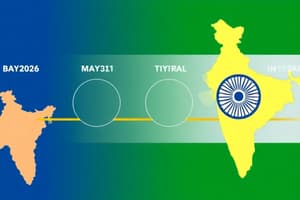Podcast
Questions and Answers
India adopted a ______ economy model after independence, blending socialism and capitalism.
India adopted a ______ economy model after independence, blending socialism and capitalism.
mixed
The Indian economic plans were executed through ______ year plans.
The Indian economic plans were executed through ______ year plans.
five
Growth, modernisation, self-sufficiency, and ______ are the common goals of the five-year plans.
Growth, modernisation, self-sufficiency, and ______ are the common goals of the five-year plans.
equity
______ reforms and the Green Revolution were major policy initiatives in the agricultural sector.
______ reforms and the Green Revolution were major policy initiatives in the agricultural sector.
The ______ Revolution enabled the government to procure sufficient food grains to build stocks for shortage times.
The ______ Revolution enabled the government to procure sufficient food grains to build stocks for shortage times.
______ substitution policy in the industrial sector increased its contribution to GDP.
______ substitution policy in the industrial sector increased its contribution to GDP.
A major drawback in the industrial sector was the inefficient functioning of the ______ sector, which led to financial losses.
A major drawback in the industrial sector was the inefficient functioning of the ______ sector, which led to financial losses.
Some economists advocate that farmers in other countries require assistance with ______ policies.
Some economists advocate that farmers in other countries require assistance with ______ policies.
One of the fundamental questions addressed in economics is, "How should goods and services be ______ among people?
One of the fundamental questions addressed in economics is, "How should goods and services be ______ among people?
Deciding whether producers should use more human labor or more capital (machines) for producing things relates to the question of how goods and services should be ______.
Deciding whether producers should use more human labor or more capital (machines) for producing things relates to the question of how goods and services should be ______.
The Five Year Plans in India aimed to determine what goods and ______ should be produced in the country.
The Five Year Plans in India aimed to determine what goods and ______ should be produced in the country.
Development policies in India from 1950-1990 focused on key sectors such as ______ and industry to foster economic growth.
Development policies in India from 1950-1990 focused on key sectors such as ______ and industry to foster economic growth.
Regulated economies involve a degree of government ______ , aiming to guide economic development but also potentially creating limitations.
Regulated economies involve a degree of government ______ , aiming to guide economic development but also potentially creating limitations.
A case study on farming methods includes examining the types of seeds, fertilizers, machines, means of ______ , costs, and income earned.
A case study on farming methods includes examining the types of seeds, fertilizers, machines, means of ______ , costs, and income earned.
Changes in cultivation methods can be gathered from elderly members of farming families, providing a ______ perspective on agricultural evolution.
Changes in cultivation methods can be gathered from elderly members of farming families, providing a ______ perspective on agricultural evolution.
Discussions on farm subsidies often involve differing views between developed and developing countries, particularly concerning the impact on global ______ .
Discussions on farm subsidies often involve differing views between developed and developing countries, particularly concerning the impact on global ______ .
Flashcards
India's Five Year Plans goals
India's Five Year Plans goals
Objectives outlining production and distribution strategies in various sectors.
Development policies (1950-1990)
Development policies (1950-1990)
Guidelines aimed at improving sectors like agriculture and industry during this period.
Regulated economy
Regulated economy
An economic system where the government controls production and distribution.
Production decisions
Production decisions
Signup and view all the flashcards
Agricultural case study
Agricultural case study
Signup and view all the flashcards
Farm subsidies debate
Farm subsidies debate
Signup and view all the flashcards
Occupational structure pie charts
Occupational structure pie charts
Signup and view all the flashcards
World Bank and IMF
World Bank and IMF
Signup and view all the flashcards
Mixed Economy Model
Mixed Economy Model
Signup and view all the flashcards
Five Year Plans
Five Year Plans
Signup and view all the flashcards
Land Reforms
Land Reforms
Signup and view all the flashcards
Green Revolution
Green Revolution
Signup and view all the flashcards
Self-sufficiency
Self-sufficiency
Signup and view all the flashcards
Public Sector
Public Sector
Signup and view all the flashcards
Marketable Surplus
Marketable Surplus
Signup and view all the flashcards
Subsidies in Agriculture
Subsidies in Agriculture
Signup and view all the flashcards
Study Notes
Indian Economy 1950-1990
- Learners will gain knowledge of India's five-year plans' goals
- Students will learn about development policies in sectors like agriculture and industry from 1950-1990
- Students will understand the merits and limitations of a regulated economy
Introduction
- India gained independence on August 15, 1947
- Jawaharlal Nehru favored socialism over other economic systems
- Nehru, and other Indian leaders, rejected the extreme versions of capitalism and socialism
- The central objective of planning in India was to initiate a process of development which would improve the living conditions and create more opportunity for a richer and more varied life.
Studying That Suits You
Use AI to generate personalized quizzes and flashcards to suit your learning preferences.




